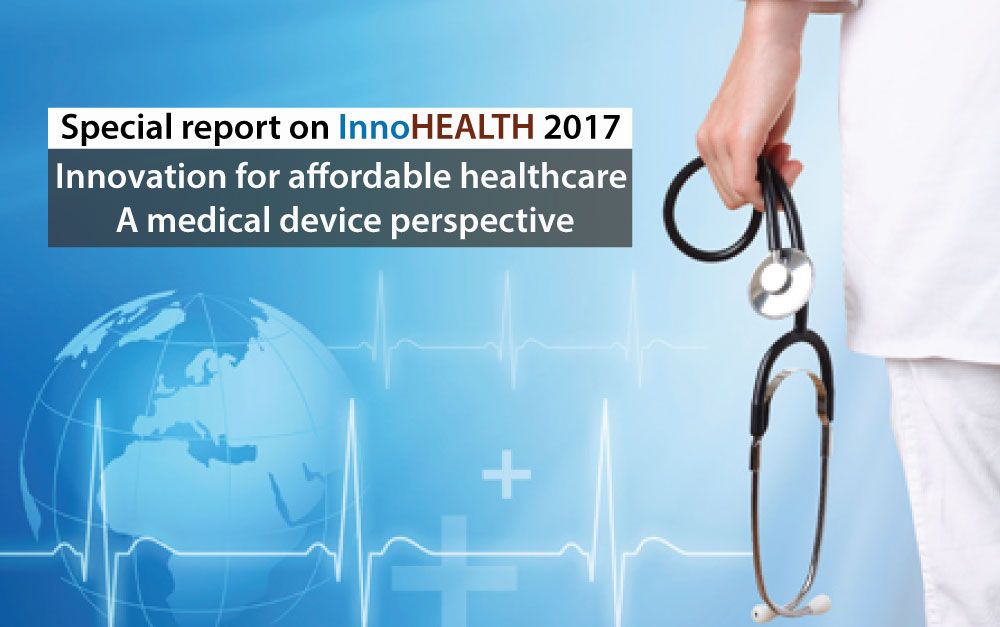New technology and its implementation will be effective if only it contributes to bringing the cost of health and medical care at a reasonable level.
Moderator: Eur Ing Muthu Singaram
Panelists:
• Stephen Victor
• Dr. Karthik Anantharaman
• Biten Kathrani
• Ashim Roy
Affordability on its own isn’t going to solve the problem of health care if we do not address other issues, voiced the panelists of the third session based on their professional experience and expertise. Costing alone isn’t the only factor in making healthcare affordable; as what is affordable to some may not be the same yard stick of affordability for others.
Intelligently moderated by the guest from IIT Madras Eur Ing Muthu Singaram, with intense participation by the audience and focused response by the panelists, the session highlighted standard problems that are universal in nature and are a concern for industry representatives from the emerging markets and the industry leaders as well.
Highlighting his concern, Biten Kathrani of Boston Scientific voiced his opinion saying, “Affordability today is very important not just for emerging markets but for the global health care environment. But in the guise of affordability and much talked about affordability, one of the critical things that we have forgotten to do in health care is to figure out challenges associated with awareness, access and adoption. So today we must look beyond affordability and not ignore awareness, access and adoption.”
Addressing the flip side of the subject of beating around about affordability, Dr. Karthik Anantharaman of BPL Medical Technologies highlighted, “Traditionally developing medical devices is very capital intensive with years of R&D that adds to the cost and makes it very unviable for the product to be of any commercial viability. The best way forward is to produce products that are of need by the doctors and not indulge in ambitious research programs that can take as long as 4-5 years of development time and just the research alone can cost a couple of millions of dollars.”
Highlighting the concern of the market towards the newly-launched products and services, another panelist Stephen Victor said, “Life cycle of a diagnostic device is not predictable as some competition may arrive in the market within six months of its launch, with additional facilities, extra benefits and probably at a cheaper cost. And there are other factors that can contribute to failure of the product despite it being very innovative and technically superior. For this, you need Curators for startups or need big corporates to invest in service and maintenance for new innovative products.”
With an emphatic conclusion about the worries of many of the startup aspirants, M.V. Amaresh Kumar, who works for Abdul Kalam Institute in Andhra Pradesh, a quasi-government establishment, emphasized, “Cost of innovation is always high as it involves immense research and investment in resources with no guarantee of market share. Government establishments like the Andhra Metric Zone and Abdul Kalam Institute have come to the rescue of such innovators who need hand-holding by someone for making new products commercially viable and relieving the inventor of such mental burden. Only such a marriage between innovators and non-profit establishments can ensure innovations to be introduced at reasonable price – not necessarily at a cheap rate, but affordable.”
“Providing complex solutions to simple problems is very easy but providing simple solutions to a complex problem is challenging. The choice of appropriate antibiotics is the simplest of solutions to a complex problem that is caused by regular intake of antibiotics especially in the case of ailments like TB, Cancer or most of the communicable diseases.”
[/vc_cta]
“Human resources is the greatest asset. But scratch a problem and you will find a human at the bottom of the problem. Aim is to motivate and improve the knowledge skills and attitude of the employees, which will benefit the system. If you want to be successful, its very simple: Know what you are doing; Love what you are doing; and believe in what you are doing. Future of management is that there’ll be more problems than human capacity to handle that. Motivation and new technology is the way forward to face these problems.”
[/vc_cta]“Affordability today is very important not just for emerging markets but for the global health care environment. But in the guise of affordability and much talked about affordability, one of the critical things that we have forgotten to do in health care is to figure out challenges associated with awareness, access and adoption. So today we must look beyond affordability and not ignore awareness, access and adoption.”
[/vc_cta]Want to write for InnoHEALTH? send us your article at magazine@innovatiocuris.com
Read all the issues of InnoHEALTH magazine:
InnoHEALTH Volume 1 Issue 1 (July to September 2016) – https://goo.gl/iWAwN2
InnoHEALTH Volume 1 Issue 2 (October to December 2016) – https://goo.gl/4GGMJz
InnoHEALTH Volume 2 Issue 1 (January to March 2017) – https://goo.gl/DEyKnw
InnoHEALTH Volume 2 Issue 2 (April to June 2017) – https://goo.gl/Nv3eev
InnoHEALTH Volume 2 Issue 3 (July to September 2017) – https://goo.gl/MCVjd6
InnoHEALTH Volume 2 Issue 4 (October to December 2017) – http://amzn.to/2B2UMLw
InnoHEALTH Volume 3 Issue 1 (January to March 2018) – https://goo.gl/fksdQx
Connect with InnovatioCuris on:
Facebook: https://www.facebook.com/innovatiocuris
Twitter: https://twitter.com/innovatiocuris
LinkedIn: https://www.linkedin.com/groups/7043791
Stay updated about IC, visit: www.innovatiocuris.com

